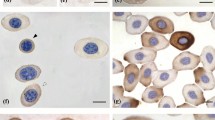Play all audios:

ABSTRACT IT is known that the amount of hæmoglobin dissolved in the blood of _Daphnia_ varies inversely with the oxygen content of the water in which the animals live. The changes in
concentration of the hæmoglobin have been studied by a quantitative method which allows measurements to be made on a single _Daphnia_ : the colour of the animal‘s blood is compared under the
microscope with known dilutions of human blood1. In the course of further work involving the use of this method it was noticed that parthenogenetic females with eggs in the brood pouch have
less hæmoglobin in their blood than those with embryos in the pouch. The difference is greatest in populations producing numerous young. Access through your institution Buy or subscribe
This is a preview of subscription content, access via your institution ACCESS OPTIONS Access through your institution Subscribe to this journal Receive 51 print issues and online access
$199.00 per year only $3.90 per issue Learn more Buy this article * Purchase on SpringerLink * Instant access to full article PDF Buy now Prices may be subject to local taxes which are
calculated during checkout ADDITIONAL ACCESS OPTIONS: * Log in * Learn about institutional subscriptions * Read our FAQs * Contact customer support SIMILAR CONTENT BEING VIEWED BY OTHERS
EVOLUTIONARY CONSERVATION OF A REGULATIVE PATHWAY OF ERYTHROPOIESIS IN POIKILOTHERMIC VERTEBRATES Article Open access 28 February 2022 MORPHOLOGICAL STUDIES ON THE PREHATCHING DEVELOPMENT OF
THE GLANDULAR STOMACH OF JAPANESE QUAILS USING LIGHT, ELECTRON, AND FLUORESCENT MICROSCOPY Article Open access 23 October 2023 MORPHOLOGICAL, CYTOCHEMICAL AND ULTRASTRUCTURAL ASPECTS OF
BLOOD CELLS IN FRESHWATER STINGRAY SPECIES IN THE MIDDLE RIO NEGRO BASIN OF AMAZONIAN BRAZIL Article Open access 03 August 2021 REFERENCES * Fox, H. Munro, _Proc. Roy. Soc._, B, 135, 195
(1948). ADS CAS Google Scholar * Teissier, G., _C.R. Soc. Biol., Paris_, 109, 813 (1932). Google Scholar * Svedberg, T., and Eriksson-Quensel, I.-B., _J. Amer. Chem. Soc._, 56, 1700
(1934). Article Google Scholar * Fraser, D. T., Jukes, T. H., Branion, H. D., and Halpern, K. C., _J. Immunol._, 26, 437 (1934). CAS Google Scholar * Andrewes, C. H., _J. Path, and
Bact._, 48, 225 (1939). Article Google Scholar Download references AUTHOR INFORMATION AUTHORS AND AFFILIATIONS * Bedford College, University of London, ELISABETH I. B. DRESEL Authors *
ELISABETH I. B. DRESEL View author publications You can also search for this author inPubMed Google Scholar RIGHTS AND PERMISSIONS Reprints and permissions ABOUT THIS ARTICLE CITE THIS
ARTICLE DRESEL, E. Passage of Hæmoglobin from Blood into Eggs of _Daphnia_. _Nature_ 162, 736–737 (1948). https://doi.org/10.1038/162736b0 Download citation * Issue Date: 06 November 1948 *
DOI: https://doi.org/10.1038/162736b0 SHARE THIS ARTICLE Anyone you share the following link with will be able to read this content: Get shareable link Sorry, a shareable link is not
currently available for this article. Copy to clipboard Provided by the Springer Nature SharedIt content-sharing initiative
